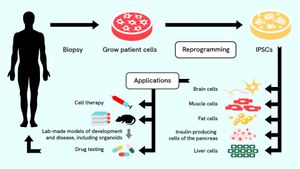A study recently published reveals how alterations in the metabolism of uridine diphosphate N-acetylglucosamine (UDP-GlcNAc) and the post-translational modification known as O-GlcNAcylation contribute to the mechanisms underpinning osteoarthritis (OA), offering new insights for therapeutic approaches.
Osteoarthritis, which affects approximately 7% of the global population, is characterized by joint degeneration and chronic inflammation. This study showed significant downregulation of UDP-GlcNAc transporters within osteoarthritic cartilage, leading to the accumulation of cytosolic UDP-GlcNAc and resulting in increased levels of O-GlcNAcylation—a modification linked to the senescence-associated secretory phenotype (SASP) observed in senescent chondrocytes.
Researchers point out, "The cytosolic accumulation of UDP-GlcNAc was similarly observed in senescent mouse chondrocytes with no significant alteration during treatments," highlighting the robustness of this mechanism across different experimental setups. This increased O-GlcNAcylation has direct consequences for the production of inflammatory mediators and matrix-degrading enzymes, significantly contributing to cartilage degeneration.
The findings suggest the interplay between metabolic stress and cellular signaling plays a central role. The study investigated primary cultured human chondrocytes and mouse models subjected to osteoarthritis, utilizing doxorubicin and bleomycin to induce cellular senescence. The results demonstrate the necessity of O-GlcNAcylation for fully realizing the SASP, impacting chondrocyte functions and contributing to disease severity.
O-GlcNAcylation was found to stabilize the transcription factor GATA4, which is known to regulate the expression of SASP factors. "O-GlcNAcylation is required for the full display of the SASP in senescent chondrocytes," adding another layer of complexity to the role of metabolic dysregulation within the pathogenic processes of OA.
This research provides new insights, indicating the compartmentalization of UDP-GlcNAc can influence the chondrocyte secretory pathways, shifting from the production of proteoglycans to inflammatory responses. The downregulation of transporters involved—identified within the solute carrier family—demonstrates the pathway is not merely affected by cellular stress but also reflects the broader changes inherent to disease progression.
Overall, the study advocates for consideration of senostatics—strategies aimed at modifying or inhibiting SASP production—as potential therapies for osteoarthritis. The targeted inhibition of O-GlcNAcylation, particularly focusing on GATA4, might serve as practical intervention to alleviate the chronic joint inflammation characteristic of OA.
This research serves as a notable step forward, shedding light on the complexity of osteoarthritis progression and establishing UDP-GlcNAc metabolism as pivotal for treatment strategies aimed at reducing the burden of this debilitating condition.



